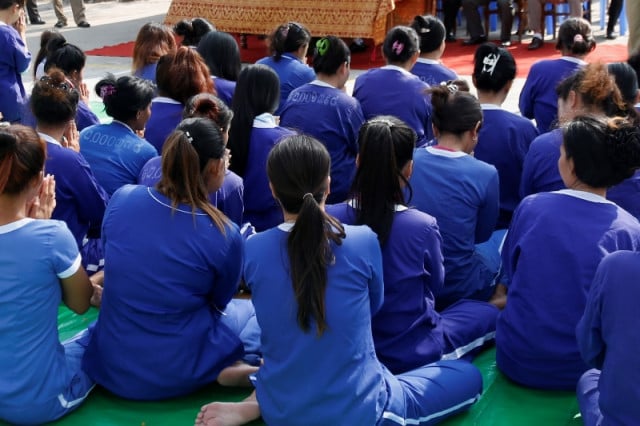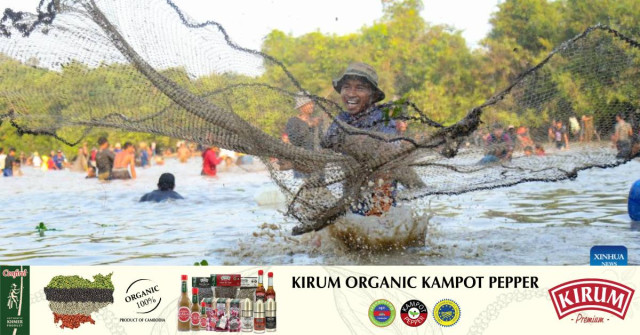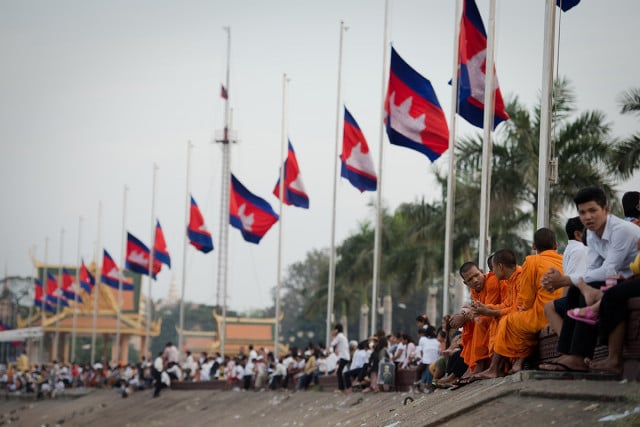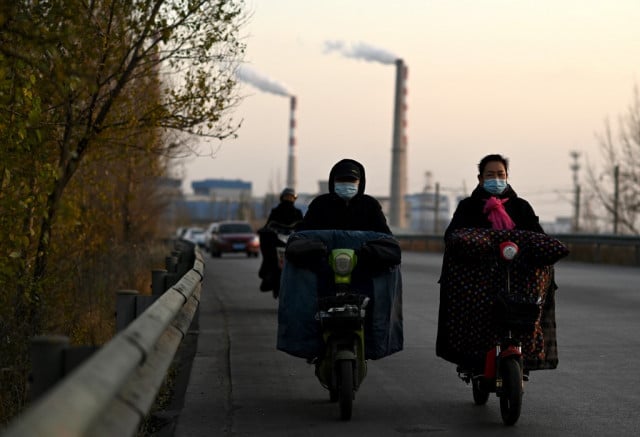Surviving the System and Building a Life After Prison in Cambodia

- Gerald Flynn and Khorn Champa
- June 4, 2020 3:30 AM
In the third and final story in our series on Cambodia’s prison system, we follow a former prisoner’s story from her arrest, to the ordeal of her detention before her eventual release in a telling recollection of the impact prison leaves on thousands of Cambodians.
PHNOM PENH--Despite improvements brought about by the widely-touted economic developments that have transpired throughout Cambodia over the last decade, the government’s proclivity for incarcerating its citizens remains concerning, according to Amnesty International. Sovann Rithy, chief executive officer of the digital media network TVFB, only had to quote Prime Minister Hun Sen accurately in a news report to experience the failings of the Cambodian justice system and the bleak conditions of its prisons.
Neither the ballooning prison population—now at roughly 40,000 by official counts—nor the deadly Coronavirus Disease 2019 (COVID-19) pandemic have inspired the Cambodian authorities to change their tactics, irrespective of the crisis brewing behind bars.
While Cambodia’s failings in running an effective and humane correctional system have been highlighted by numerous rights groups, such failings are not Cambodia’s alone. Much of Southeast Asia has experienced gross overcrowding in prisons following a range of ineffectual anti-drugs campaigns that have led to a general failure in delivering justice. But no matter how much evidence amasses highlighting these issues, policymakers stride on regardless, dismissing uncomfortable facts presented by national and international organizations as partisan criticism.
“By some accounts, as outlined in our ’10 years of drug policy in Asia’ report in 2019, over 20,000 people have been killed by unknown assailants or police since 2016 as a result of being suspect of having some involvement with drugs and there has only been prosecutions [of police officers] for one of those people killed; 17-year-old Kian de los Santos,” said Gloria Lai, regional director for Asia at the International Drug Policy Consortium, based in Bangkok.
When asked how bad things need to get before governments of Southeast Asia change course from the catastrophe they are sleepwalking into, Lai noted the extensive chaos and destruction that has resulted from hardline drug policies.
“This hasn’t proven to be a tipping point, so I find it difficult to say what a tipping point would be,” she said.
As this series has explored, the law has not ushered in order, let alone justice, in Cambodia and for those who have endured the country’s unique flavor of incarceration for non-violent offenses, the scars of the experience are indelible.
Women and Children in Cages
Speaking to Cambodianess on the condition of anonymity, Bopha—which is not her real name—is happily married, in her thirties and mother to several children. She is also a former prisoner who has only recently been able to enjoy her freedom after nearly nine months behind bars.
“I was staying home, taking care of my children at the time,” she explained. “My husband was struggling to find construction jobs. Times got hard, there was no work for my husband and we couldn’t afford the rent. Our landlord didn’t care that we couldn’t pay, he kicked us out and so we went to the local pagoda to ask for shelter,” Bopha recalled.
Perhaps reflecting the inadequacies of gross domestic product as a measurement of any nation’s success or perhaps due to the rampant corruption that Cambodia is sadly famed for, the infamous 7 percent average annual economic growth has failed to truly lift the 16.5 million-strong population out of poverty and into prosperity.
Ministry of Social Affairs, Veterans and Youth Rehabilitation spokesperson Touch Channy recently said that some 2.4 million Cambodians lived in poverty, which would represent roughly 14.5 percent of the population. But a 2018 analysis from the United Nations Development Program (UNDP) found that 37.2 percent of Cambodians are living in multidimensional poverty—a measure that goes beyond income and takes into account access to healthcare, education and standard of living.
The UNDP found that 13.2 percent of Cambodians were living in severe multidimensional poverty in 2018. Bopha, homeless and impoverished, was not alone when she decided to steal: She, like millions of Cambodians, was desperate.
“It wasn’t really planned or something I thought through, it felt wrong stealing,” she explained, adding that she’d never stolen anything before. Cambodianess has removed details of Bopha’s exact crime to protect her identity and privacy.
It was only later that the police paid Bopha a visit. She was taken from her home to the police station where she was asked to sign an agreement not to steal again—one of her children was taken with her.
“I agreed of course, but what I didn’t expect was to be held after I signed. I thought I would go home after that, but they kept me there and told me that I should know what I needed to do in order to get out; I think the police wanted money,” she explained.
Bopha recalled how the police gave her husband some time to find the money—although the amount was never made clear to her or her husband—but as Bopha noted, both her and her husband automatically knew that it was money that the police were demanding in exchange for her freedom.
In their 2019 Bribery Risk Matrix, TRACE International—a non-profit business association founded in 2001 to provide multinational companies and their commercial intermediaries with anti-bribery compliance support—ranked Cambodia 189th out of 200 countries analyzed, suggesting that bribery has become a fundamental element in both public and private life here.
“It was maybe four or five days later when my husband came back with all he could find, $50 in total, but it was not enough. They [the police] took the money, but the next morning I was sent to court without a lawyer and then—again, without a lawyer—was placed into pre-trial detention,” Bopha said, straining somewhat to recount the details of events that led to her time behind bars.
“I had my child with me when they locked me away, nobody told me how long I’d be in prison and so I wait—with my child, behind bars—to find out what my sentence is from a judge,” Bopha recalled, adding that she despaired at how her husband and her other children would cope without her.
The Problem with Pre-trial Detention
This is no recent phenomenon though, as local human rights group LICADHO pointed out in a 2015 report following an analysis of 14 Cambodian prisons and interviews with 96 women who had been imprisoned with their children. Despite the fact that all the women interviewed were accused or found guilty of minor non-violent crimes and had dependent children under the age of 18 years old, LICADHO learned that 70 percent of the women interviewed had no access to legal counsel, 56 percent were detained on drug charges, 97 percent had never been in prison before and that all of the 96 women were detained before they stood trial.
Of the women interviewed, 32 of them received no visit from their children while incarcerated, and of those who did receive visitors, 94 percent reported that their families had to pay to visit the prisons. However, under Cambodian law, children under the age of 3-years-old can stay with their mothers in prison.
“There is no doubt that, in the majority of cases, the imprisonment of a mother can have deep and long-lasting psychological and developmental consequences for her children and may increase the likelihood that the children themselves later come into conflict with the law,” LICADHO’s report found, adding that this in turn creates a string of issues from childcare, access to both health and education, along with the right to family contact.
LICADHO’s monitoring of the situation has shown little to no change in the government’s approach to placing mothers and their children in pre-trial detention, irrespective of the impact this has on either.
“Children under three are amongst the most vulnerable groups of detainees,” LICADHO wrote in an October 2018 report. “Their detention is a direct by-product of inappropriate pre-trial detention and the refusal to grant bail to their mothers.”
The rights group found that Cambodia’s penal system reached an all-time high of putting children in cages in 2017, with 179 children reportedly behind bars—the majority of whom were under two years of age. By July 2018, LICADHO found there were 138 children accompanying 135 mothers and a further 30 pregnant women behind bars, with 80 of the 165 women being held in pre-trial detention.
The impacts of unnecessary pre-trial detention, LICADHO said, cannot be overstated. Pre-trial detention typically lasts six months, but can be extended by a further two six-month periods and a settlement warrant can allow pre-trial detention to stretch on another four months, meaning the total possible time a Cambodian adult can spend behind bars without standing trial is 22 months, according to Article 208 of the Cambodian Criminal Procedure Code.
Similarly, in March 2020, LICADHO found that there were 103 children and 43 pregnant women living behind bars across the 28 detention centers nationwide as of January 2020. Subjected to inhumane levels of overcrowding, daily acts of violence and squalor, as well as scarce access to food, water and healthcare, the women raising their children behind bars need alternatives to pre-trial detention, LICADHO argued. This was tragically underscored by the death of an infant behind bars. The mother had been placed into pre-trial detention, setting in motion a series of events that would lead to the death of a 5-month-old baby.
Pradeep Wagle, the United Nations (UN) Human Rights’ representative in Cambodia, agreed on the need to use pre-trial detention as a last resort for certain groups. “We also advocate for the appropriate use of alternatives to detention such as judicial supervision or sentence reduction and pardon, especially for pre-trial detainees and vulnerable populations such as women with children, pregnant women, older detainees, chronically ill or juvenile detainees.
Bopha and her child served eight of the nine months she was sentenced to before she stood trial. “We were locked in an overwhelmingly crowded cell with 24 or 25 other prisoners.
“We all shared the same toilet—only one toilet for all those women. Most of them also had small children with them. We were given one pot of rice and food. Whether it was enough for all the women and children, the guards didn’t care. So there were always fights, pretty much every day, over who got food,” she said, adding that mothers who were breastfeeding were seen as needing more food, but this only caused more conflict within the cell.
“When I first arrived, I experienced some violence from the other prisoners, but the guards: They didn’t care, even when people were fighting,” Bopha said. “If someone got sick, we would have to scream and scream to get the guards to help us. Life in prison was so difficult, I never want that feeling again.”
She went on to detail how every day was a worry, not for her own wellbeing, but rather for ensuring her child’s safety. She also was consumed by the fear of what was happening to her other children left alone with her husband, who had fortunately found work again. “They were living outside with no place to stay. I missed them so much and felt so much pity for them: How could he take care of them in those circumstances?” she asked, exasperated by the memory.
While Cambodia, like the other UN member states, has adopted what have become colloquially known as the Bangkok Rules, the sheer volume of women who incarcerated on pre-trial detention—especially those who are mothers to dependent children—suggests that Cambodia is failing to meet its obligations internationally.
Prison Amenities Fail the Poor
For Bopha, who saved all her money to ensure that her baby had food and diapers, the programs in place for prisoner development were of little help.
“I remember seeing that there were vocational training programs, ones where a prisoner can learn to become a tailor,” she said. “There were classes on embroidery and even traditional dancing, but it’s not for someone with a small child like me.
“I used to hear about a prison library,” Bopha recalled. “But you had to spend 1,000 riel ($0.25) to rent a book. I didn’t have the money. So I never had the chance to read. I don’t even know where the library is in the prison or what it looks like: I just didn’t have the money.”
Sam Leang Eng is the prison library coordinator at Sipar, an NGO dedicated to making Khmer-language books available to Cambodians with little or no resources, also ensuring that prisoners in Cambodia have access to books and, in many cases, learn how to read them.
Sipar has provided more than 100,000 books to 26 of Cambodia’s prisons, Leang Eng said. But the lack of quality books available in the domestic market poses a challenge—which is one of the reasons why Sipar also publishes books in Khmer.
Leang Eng has observed an increased demand for books in prison. “We provide a second chance to the detainees who are illiterate by helping them to improve their literacy levels through classes in partnership with the Department of Non-Formal Education of the Education Ministry and through the encouragement of collaboration between prison officers librarians and literacy teachers,” he explained.
Noting that data on literacy rates in prison is scarce, Leang Eng said he estimates that between 30 and 40 percent of all prisoners were deemed illiterate in 2015. He noted that this was before the literacy classes had been rolled out to all prisons.
Life on the Outside
For Cambodians like Bopha, who dropped out of school in Grade 9, the lack of access to books or literacy courses further restricts the possibility of a prosperous life once released from jail. Leang Eng believes that numerous prisoners—particularly those on bail or those incarcerated for serious crimes—are unable to partake in Sipar’s programs or use prison library services. Given that female prisoners tend to receive harsher punishments for low-level crimes and typically come from low income socioeconomic backgrounds, the ability to develop skills while imprisoned is often beyond their reach.
Sipar is able to provide the books, but generally lacks the capacity to follow up with prisoners upon their release to see how effective their programs are, Leang Eng said.
“The follow-up of released prisoners is a crucial issue very difficult to address, even for the authorities,” he said. “But within the framework of the project, Sipar is partner of two local NGOs, Mith Samlanh and M’lop Tapang, to implement reintegration preparation sessions [to provide] the soft skills necessary for prisoners to reintegrate society and to find a job.”
Between them, Mith Samlanh and M’lop Tapang are able to monitor the post-incarceration development of some 70 percent of their beneficiaries. Sipar typically relies on surveys and evaluations conducted by external consultants to assess the efficacy of their work.
Sampling from a number of prisoners Mith Samlanh worked with in 2019 and 2020 shows that 87 percent of them did not attend secondary school, 13 percent of them were illiterate and the majority of them had no hard skills.
Pisith Horn, coordinator of the program Building Futures at Mith Samlanh, notes that recent years have brought about many positive developments relating to providing former prisoners with vocational training, education and skills for reintegration.
“Many [former] prisoners claim they migrated for work in other provinces or countries, or were involved in training programs, and therefore they may not face severe discrimination,” Horn said, when asked of the issues ex-offenders face on the outside.
Despite this, Horn noted that prison does inevitably leave an impact on many Cambodians. Emotional disorders develop out of the traumatic neglect and this, he said, can lead to violence and aggression, which creates a vicious cycle of recidivism. This correlates with the findings of Amnesty International’s report to the effect that time in prison can have severe, long-term impacts on the well-being and prospects of those who are jailed.
“Based on Mith Samlanh’s experiences with ex-offenders, mainly those who were imprisoned for drug-related crimes, about 10 percent of them go back to prison for a second or even third time,” he said.
When Bopha finally stood trial, more than eight months following her arrest, she said she didn’t understand the procedures or what was happening to her and her child.
“When they called my name in court, I felt happy and afraid at the same time because I didn’t know how many years I would stay in prison,” she said, adding that it was through the persistence and support from an NGO that she was able to find legal counsel once imprisoned.
“Then they said I would only serve nine months total and I just broke down in tears: I was so happy,” Bopha recalled.
“When I finally got out of prison, I promised myself to be a good citizen and not to do bad things,” she said. “On that day, when the NGO came to find me, I was able to leave with them.
“But things are very difficult since I left: I have nothing now,” she sighed.
Bopha now lives with her family in her home province. But the financial problems that plagued her before her incarceration have not gone away and she is worried about how the community feels about her. She does not know what she will do but remains cautiously optimistic.
“I am happy now, though I live in a very small house,” she said. “[P]eople encourage me, so I have more confidence and hope to work and earn money. I want to live happily with my family and I don’t want money: just my family’s happiness.
“Money, we can have later, but happiness is more important,” Bopha added.
For the full story, check out parts one and two of our series on Cambodia’s prison system.















